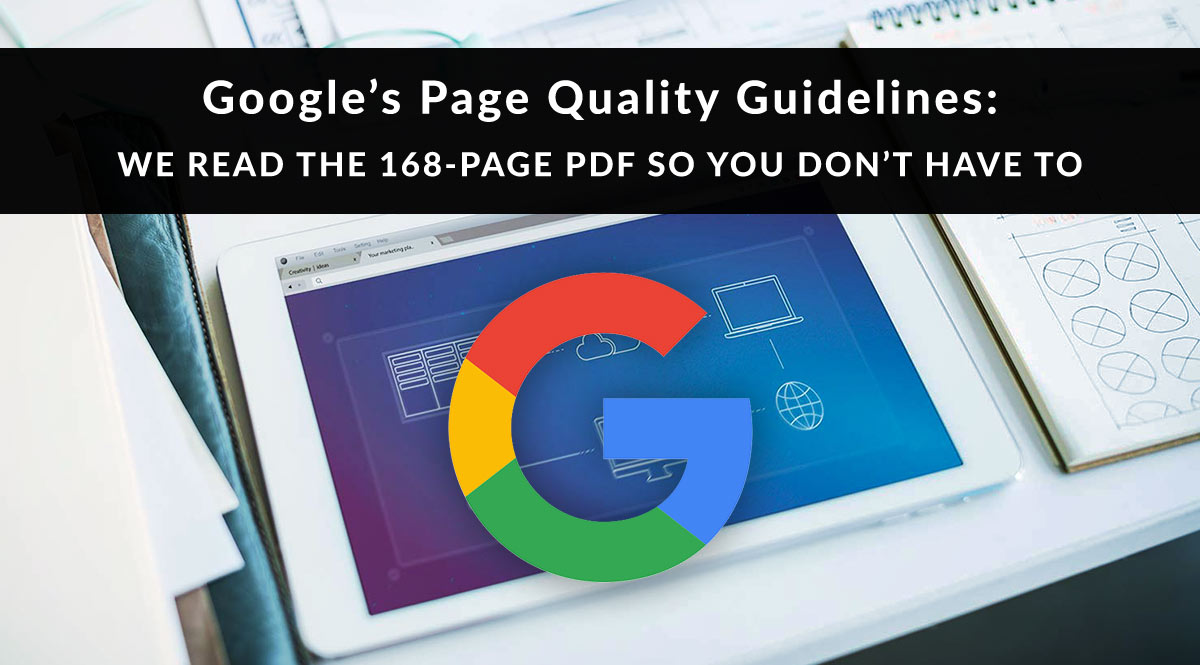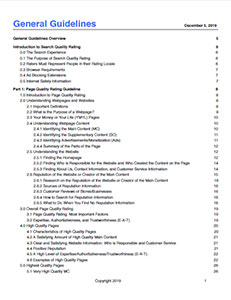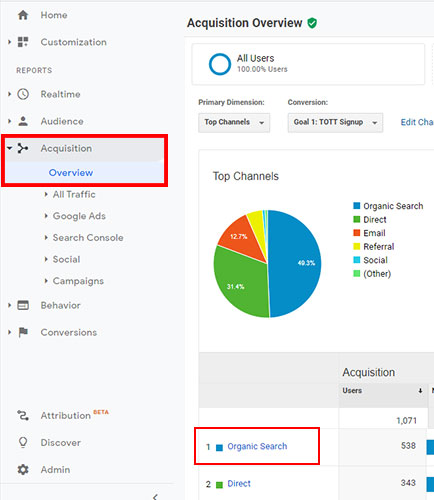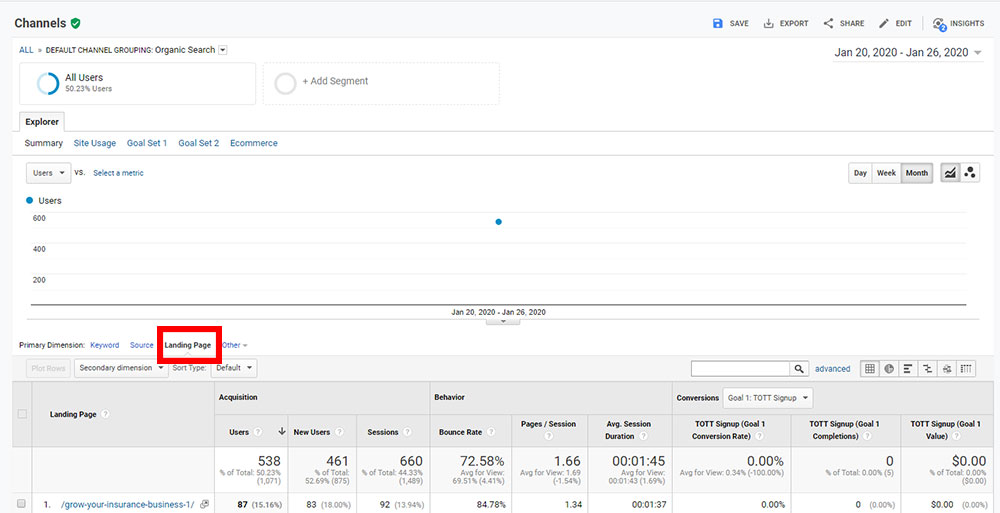
No one knows the exact combination of factors that cause a site to rank well in Google’s search results. Outside of technical SEO, however, one big ranking factor is the content’s overall quality.
No time to read? Watch our video overview:
This raises an important question - what does "quality" mean? Add your definition in the comments and see how it compares to Google's, as we go through the evidence below! To get that evidence, we need to turn to a source outside the algorithm - Google's human reviewers. Google uses human reviewers to rate site content because they want to know if human reviewers and the algorithm both reward the same type of sites.

To help these site reviewers, Google created a document explaining how to evaluate what it calls “Page Quality.” You can view or download it here. There are four possible ratings a reviewer can give a page: lowest, low, medium, high, and highest. This document is updated from time to time, giving us clues to what Google is looking for. If you’re willing to wade through a 168-page PDF, you can find those clues.
I decided to do just that.
Jump to a section:
Why Do Page Quality Guidelines Matter?
YMYL Pages
5 Interesting Tidbits from the Guidelines
Your 8-Step Plan to Incorporate These Guidelines
But First…Why Do Google’s Page Quality Guidelines Matter?
Keep in mind that following these guidelines is no guarantee that your site will rank well. After all, according to a 2018 study by Ahrefs, only 9% of content gets any organic traffic at all.
But not following them? That leaves your site open to a potential decrease in traffic.
That’s exactly what happened in 2018 with the so-called “medic” algorithm update.
This algorithm change rewarded sites that met Google’s current content quality standards and penalized sites that didn’t. Pages with thin content written by entry-level freelancers or uncredited writers (read: non-experts) lost visibility in search results. Sites like Prevention, LiveStrong, MensHealth, and BuzzFeed were especially hard hit. Because many of the hardest-hit sites covered health-related topics, the update earned the nickname "medic."
Has your site ever been hit by a Google algorithm update?
Sound off - tell us in the comments!
At this point, one thing is clear: Google wants to know that a site and the person who wrote its content are trustworthy, well-qualified sources of information.
So what does all this mean for your agency’s site?
Let’s take a look at what Google says – then we’ll figure out how to apply it to your site.
Your Money or Your Life
Google puts insurance websites in a category called YMYL, “your money or your life.” If a site offers information that “can potentially impact a person’s future happiness, health, financial stability, or safety,” that site is YMYL (10). These pages are held to a higher content standard than, say, a humor site or personal blog.
That standard is described with an acronym, E-A-T.

Here's what that all means for you, the owner of a website providing content for consumers.
- Expertise: Are you an expert on this topic? Are you qualified to provide web searchers with the information they’re looking for?
- Authoritativeness: Is your website a credible source for this information? Do people know you and turn to you because you’re well-known in your field?
- Trustworthiness: Is your website trustworthy? Does it have a clear and helpful purpose? Is it easy to find information about the site and whoever produces its content? If there are ads, are they easy to distinguish as ads (and not misleading site visitors into thinking they’re the main content)?
But that’s not all.
There’s an entire chapter in the guidelines devoted to reputation. Google asks its quality reviewers to research a company, organization, or entity outside the site itself to get a feel for their reputation.
Why does reputation matter so much to Google?
Because “when a high level of authoritativeness or expertise is needed, the reputation of a website should be judged on what expert opinions have to say” (16). Google advises quality reviewers to search for those expert opinions in news and magazine articles, Wikipedia, Yelp, the Better Business Bureau, blog posts, forum posts, and ratings/info from independent organizations.
In other words, you can tell the world you’re an expert – but unless the world backs up your claim, Google won’t believe it.
5 More Tidbits from Google’s Page Quality Guidelines
Okay, so we know Google is looking for authority, reputation, and trustworthiness. Can we glean anything else from the Page Quality review guidelines?
Here are a few quotes that stood out to us, with the relevant parts in bold. In the next section, we'll go over ways to apply these guidelines to your site.
- “High E-A-T financial advice, legal advice, tax advice, etc., should come from trustworthy sources and be maintained and updated regularly” (20).
- “Formal expertise is important for YMYL topics such as medical, financial, or legal advice” (27).
- “You must consider the reputation and E-A-T of both the website and the creators of the MC in order to assign a Page Quality rating” (58).
- “Pretty much any topic has some form of expert, but E-A-T is especially important for YMYL pages” (64).
- “High quality pages involve time, effort, expertise, and talent/skill. Sharing personal experience is a form of everyday expertise” (64).
Do any of these guidelines surprise you?
We were surprised by the emphasis on reputation - how about you?
Your 7-Step Plan to Incorporate These Guidelines
Your site needs to convince Google that you’re an expert who can be trusted to give a consumer advice about insurance. Let’s create a plan of action that helps make sure your site does just that, based on the Page Quality guidelines.
Step 1: Update info about yourself on the site
Make sure your “About” page showcases your experience and expertise. If your content includes an author bio beneath blog posts, update that, too. Here is what you want to include or update:
- Degrees or licenses you hold – this speaks to the “formal expertise” in the guidelines
- Number of years of experience
- Other stats that reveal experience: a dollar value for policies sold last year (or all time), number of clients helped over the past 5 years, etc.
- Professional societies you’re a member of
- List any publication credits you have. If you have a lot, include the 3-5 most well-known or relevant to the industry. This might include your own blog and/or podcast.
- List any speaking engagements you’ve had. If you have a lot, include the 3-5 most well-known or relevant to the industry. This may include guest appearances on podcasts.
Step 2: Make sure landing and sales pages have contact info
Part of being trustworthy is making it easy for the consumer to reach you if they have questions or problems. Take a look at your landing pages, quoter pages, and sign-up pages.
- Is your licensing info there?
- Can a consumer find out how to contact you quickly and easily?
- Do you have links to your ratings or reviews on Yelp, the Better Business Bureau, or other review sites?
Step 3: Make sure your site is trustworthy
By looking at the guidelines for rating a low-quality site, we can reverse-engineer what Google believes are the characteristics of a trustworthy site. Most of these should be a no-brainer:
- Have a beneficial purpose (i.e., helping the viewer)
- Don’t use scraped or copied content
- Have an appropriate amount of content on a page (enough to fully answer the search query)
- Don’t use auto-generated content
- Don’t obstruct or make your main content inaccessible
- Have plenty of information about you and your agency
- Don’t include content that potentially spreads hate
- Don’t include content that misinforms or deceives users (“YMYL content that contradicts well-established expert consensus,” 39)
- Make sure you have no malicious links on your site (phishing, scams, malware, etc.)
Step 4: Make sure you’re asking clients to review you off-site
Google quality reviewers check for ratings and reviews on sites like Yelp and the Better Business Bureau. Make sure you’re getting a steady trickle of content added to these sites. The easiest way to do that? Make sure a review request goes out in your new client onboarding package (we wrote about that here).
Step 5: Plan to update your best-performing pages
Remember that bit in the guidelines about pages being “maintained and updated regularly”? Here’s how to address it.
Open Google Analytics. In the left-hand main menu, go to the Acquisition menu, click the dropdown button, and click Overview. In the list of acquisition channels, click Organic Search.

Next, look for the Primary Dimension selector at the top of the list. Select Landing Page.

These are the pages site visitors landed on when they first came to your site. To scroll further down the list, use the left and right arrow keys on the bottom-right of your grid. Which 10-15 pages are bringing you the most site visitors? If you’ve set up conversion goals, use the Conversions dropdown menu on the top right of your grid to see which pages are converting the best by goal.
Keep an eye on these lists so you know which pages are continuing to perform well. When you see one of these slip out of your best-performers list, it’s time for an update. Make sure all the info is current, and see if there’s anything you can add in terms of context, examples, case studies, or new information.
Step 6: Update your worst-performing pages
Go back to Google Analytics. Repeat the steps above until you get to the Organic Search / Landing Page list. This time, look at your Users column. Click the down arrow (view results in descending order) to change it to an up arrow (view in ascending order).

These are the pages that drew in the fewest number of site visitors from organic search. Are any of those meant to be heavy-hitting pages? Are you expecting these pages to capture visitors and drive them to your quoter?
If so, they need to be revised with an eye to SEO:
- Is there a focus keyphrase?
- Does it appear in the page title, first sentence, at least one subheading, an image caption, an image URL, and the meta description?
Once you’ve covered these SEO basics, make sure the page meets a searcher’s need. What would they have Googled to get to this page? What else might they need or want to know?
Step 7: Be Careful with Freelance or User-Generated Content
We’re not saying you can’t use content written by others. You just have to keep these considerations in mind:
- Is the content at least as good (if not better) than what you normally put out?
- Is the content thorough enough to provide a quality answer to a search query?
- Does the content cite authoritative sources?
- Are you going to credit the author? Do they have a bio that adds to the expertise quotient of your site?
- Does the content cover a topic that only a subject matter expert like yourself should address (i.e., retirement planning and investment strategies)?
Step 8: Get or Stay Visible in the Industry
If you don’t have things like publications, speaking engagements, or podcast guest appearances, now’s the time to start branching out! The more you’re seen and quoted within the industry, the more signals you’ll be sending that you’re an expert and an authority.
But don’t worry if this sounds like a big task. It isn’t something you need to achieve all at once.
The quality reviewer guidelines specifically mention that if no sources are available to evaluate a site, company, or content creator’s reputation, they should not take that as a reason to give the content a low rating. Focus on serving your clients, adding quality content to your site, and building your visibility within the industry. You’ll be in good shape, according to the Google Page Quality guidelines!
That’s our look at Google’s Page Quality guidelines!
What else do you want to know about Google's Page Quality guidelines?
We'll dig through the document to try to find an answer for you!
